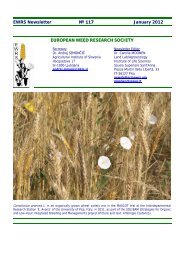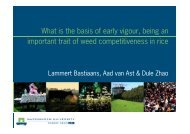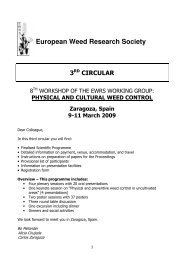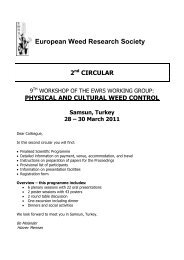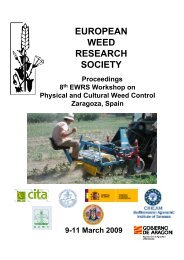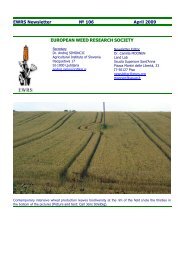Physical and Cultural Weed Control Working Group of - European ...
Physical and Cultural Weed Control Working Group of - European ...
Physical and Cultural Weed Control Working Group of - European ...
Create successful ePaper yourself
Turn your PDF publications into a flip-book with our unique Google optimized e-Paper software.
9 th EWRS Workshop on <strong>Physical</strong> <strong>and</strong> <strong>Cultural</strong> <strong>Weed</strong> <strong>Control</strong> 16<br />
Samsun, Turkey, 28 – 30 March 2011<br />
The effect <strong>of</strong> some trap crops on Orobanche aegyptiaca<br />
damage reduction in tomato<br />
H. Alizadeh 1 , S. Babaei 2 , M.R. Jahansouz 1 , H.R. Mashahadi 1 <strong>and</strong> M.M. Moeini 3<br />
1- Academic member <strong>of</strong> University <strong>of</strong> Tehran<br />
2- PhD <strong>Weed</strong> Science Student, University <strong>of</strong> Tehran, Iran. Email: sbabaei@ut.ac.ir<br />
3- Assistant Pr<strong>of</strong>essor <strong>of</strong> Plant Protection Research Institute<br />
One <strong>of</strong> the most susceptible hosts <strong>of</strong> the Phelipanche aegyptiaca (pers.) Pomel (Egyptian<br />
Broomrape) is tomato. Broomrape causes yield loss in tomato due to severe infestations in many<br />
regions <strong>of</strong> Iran. The main objective <strong>of</strong> this investigation was to evaluate <strong>and</strong> compare the effect <strong>of</strong><br />
some trap crops on reducing the broomrape damage <strong>and</strong> to increase the yield <strong>of</strong> tomato in<br />
broomrape infested field. Trap crops consisting <strong>of</strong> Egyptian clover, sesame, mungbean, common<br />
flax, brown Indianhemp, cotton, pepper <strong>and</strong> black-eyed pea were studied during 2008 <strong>and</strong> 2009.<br />
Through the first year, trap crops were cultivated in pots <strong>and</strong> in the next year, tomato was<br />
transplanted into those pots.<br />
Results showed that Sesame, brown Indianhemp, common flax <strong>and</strong> black-eyed pea decreased<br />
broomrape biomass by 86, 85.3, 75.2, <strong>and</strong> 74.4%, respectively. Reducing broomrape biomass<br />
caused increases in the tomato yield. Meanwhile, sesame, brown Indianhemp, Egyptian clover <strong>and</strong><br />
mungbean increased total biomass <strong>of</strong> tomato by 71.4, 67.5, 65.5, <strong>and</strong> 62.5 %, respectively. It was<br />
found that these plants have a great potential to reduce broomrape damage <strong>and</strong> they can be used in<br />
rotation in broomrape infested fields.<br />
References<br />
Hershenhorn J, Goldwasser Y, <strong>and</strong> Plakhine D. (1996). Role <strong>of</strong> pepper (Capsicum annum) as a trap <strong>and</strong> catch crop for<br />
control <strong>of</strong> Orobanche aegyptiaca. <strong>Weed</strong> Sci. 44, 948–951.<br />
Kebreab E, <strong>and</strong> Murdoch AJ. (1999). Effect <strong>of</strong> moisture <strong>and</strong> temperature on the longevity <strong>of</strong> Orobanche seeds. <strong>Weed</strong><br />
Res. 39, 199–211.<br />
Kliefeld Y, Goldwasser Y, Herzlinger G, Joel DM, Golan S, <strong>and</strong> Kahana D. (1994). The effect <strong>of</strong> flax (Linum<br />
usitatissimum L.) <strong>and</strong> other crops as trap <strong>and</strong> catch crops for control <strong>of</strong> Egyptian broomrape (Orobanche<br />
aegyptiaca Pers.). <strong>Weed</strong> Res. 34, 37–44.



